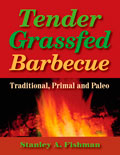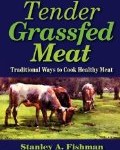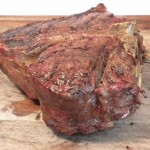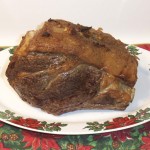Before Weight Loss Surgery — Try Grassfed Fat
By Stanley A. Fishman, author of Tender Grassfed Meat and Tender Grassfed Barbecue
The FDA recently claimed that some advertisers of “Lap Band†weight loss surgeries were not properly disclosing the many dangers of the procedure.
It is a total mystery to me why anyone would accept the risks of surgery if they had any alternative. Why anybody would accept mutilation, internal scarring, and the insertion of a foreign device into their bodies. To have this done for the purpose of losing weight is incomprehensible to me.
But it is supposed to be so hard to lose weight, and to keep the weight off. And weight loss surgeries like gastric bypasses and the “Lap Band†are supposed to make it easy.
But there is a much safer and ultimately easier way that will work for most people. A way that was in common use before World War II, from a time when obesity was very rare. A way that is simple and effective. This is the “secret†that was commonly used in the early twentieth century, with great success—eat a low-carb, high-fat diet.
Weight Loss Before
Before animal fat was demonized by the completely discredited “lipid hypothesis,†there was no massive diet industry. There were no surgeries for weight loss. There was very little obesity. If somebody wanted to lose weight, the common medical response was to prescribe a low-carb, high-fat diet. This was so effective in achieving weight loss that obesity was not a problem. And people did not suffer from malnourishment with such a diet, as grassfed animal fat is one of the most nutrient-dense substances on Earth.
The food at that time was also different. There was much less processed food. Meat was always grassfed and grass-finished. While there was far too much sugar in the diets of many people, going on a low-carb, high-fat diet would remove the sugar-heavy foods and the carbohydrate-rich foods. People who went on the low-carb, high-fat diet would usually eat large amounts of pastured animal fats such as butter, lard, beef tallow, and fatty meats, from animals that were grassfed and pastured. The fat of grassfed animals is rich in CLA, a nutrient that actually reduces body fat. It was not hard for most people to stay on such a diet, because the animal fats are so satisfying.
Weighing too much was simply not a problem for most people, and when it was a problem, there was an easy solution that worked for almost everybody.
And there was no market for a huge diet industry.
The Change
Obesity started to become a huge problem after World War II. The fear of cholesterol was created, and eating fat was identified with consuming cholesterol. Animals in the U.S. were finished in feedlots, a practice that resulted in the animal losing almost all the CLA in its meat and fat. Doctors stopped prescribing the low-carb, high-fat diets that had been so effective in the past, because of the fear of animal fat. People ate more and more high-carbohydrate, processed foods, more sugar, and more food additives. At the same time, they greatly reduced their consumption of animal fats and greatly increased their consumption of vegetable oils that could only be made with modern technology.
The result? Americans became fatter, and fatter, and fatter. The diet industry was born.
Weight Loss Now
You would think that something would have been learned about the fact that high-carbohydrate, low-fat diets make people fat, after decades of experience. And you would be right. Unfortunately, one of the things that was learned is that such a diet would make huge numbers of people fat, and that a fortune could be made by keeping them fat and giving them weight loss programs that would provide only temporary relief. Thus, we have a multi-billion-dollar diet industry, a segment of the medical industry that “treats†obesity, and millions of suffering people who are exploited by these industries.
Millions of people starve themselves, and exercise themselves into exhaustion as they follow these programs and get advice from medical professionals, in a desperate attempt to lose weight. Most people who lose weight, after much effort, suffering, and expense, gain it back, and the whole horrible cycle starts again.
This has led to the creation of “weight loss†surgical procedures, which promise an easy way to keep weight off. Two of the most popular are gastric bypasses and “Lap Bands.â€
A gastric bypass actually involves stapling the stomach, and rerouting the food digestion so the small intestine is avoided. Normally, all food passes through the small intestine, which is crucial to digestion. This make it impossible for the body to function properly in digesting food, which leads to weight loss.
A “Lap Band†involves the surgical, interior attachment of an inflatable belt around the stomach. The belt constricts the size of the stomach, so it cannot expand to hold more food to digest. This makes it impossible for the stomach to function properly in digesting food, which also leads to weight loss.
Both of these procedures have many risks and a high chance of serious side effects, which often lead to more surgeries to try to correct the problems that arise.
The Solution
My own personal experience has convinced me that the best way to deal with almost any body issue is to strengthen the natural functions of the body, by eating a nourishing traditional diet, full of foods rich in pastured animal fat. Surgeries that interfere with and disable the natural functions of the body are something that I would never agree to.
If weight is the issue, the low-carb, high-fat diet is tried and true. It is important to eat only real food and grassfed meats when you are on such a diet, as those were the foods available when the diet was common and obesity was rare.
I am not giving medical advice, just writing about how things were done and about my own experience. If you have a medical issue, you should consult a medical professional, preferably one who treats each patient as an individual and is open to new ideas.
There are many such diets, with the Atkins diet being the most famous. The book “Eat Fat, Lose Fat†by Sally Fallon Morell, describes an effective high-fat diet, using a Weston A. Price perspective. My friend Jimmy Moore is devoted to providing information on low-carb, high-fat diets, and there is a ton of useful information on his website, Livin’ La Vida Low-Carb Blog. Jimmy will also answer questions about the subject by email.
This post is part of Monday Mania, Fat Tuesday, Real Food Wednesday, and Fight Back Friday blog carnivals.
When It Comes to Meat — Study the Studies First
By Stanley A. Fishman, author of Tender Grassfed Meat
It was the first hour of the first class on my first day in law school. The teacher, a man who actually practiced law during the day, and taught it at night, wrote a statement on the blackboard. I can still see the words in my mind. “There is no truth.â€
Being a believer in the truth of science in that time, I had to challenge that. I asked, “But what about scientific truth, established by properly conducted studies?â€
The teacher, an attorney of vast experience, answered—“No matter what position you take in a lawsuit, you can always find an expert to support it, and the expert can always find studies to support his position. You will find an expert who will testify that 2 plus 2 equals 3, and the other side will find an expert who will testify that 2 plus 2 equals 5. And each of them will find studies to support their completely contradictory positions. That is why there is no truth, at least not when you are practicing law.â€
After more than a quarter century as an attorney, I found his words to be absolutely true. Whenever there was an issue of science, psychology, medicine, or just about anything else, each side in the lawsuit was able to find an expert, often a superbly qualified scientist, to support their position. And every expert was able to find studies to support his or her support of that position.
This is not to say that every scientist is corrupt. But it does show that scientists who study the same issue often come up with results that contradict each other. The differences arise from the details of the study, the assumptions made that will be accepted as fact but not tested, and the bias, both subconscious and actual, of a scientist whose future income depends on pleasing the customer who is paying for the study. It is crucial to understand these factors before you accept the conclusions of a study as true.
Let us look at the studies on meat, for example. We have been bombarded for the last fifty years with study after study that claims that meat is unhealthy. According to various studies, meat causes heart disease, cancer, strokes, aging, and many other illnesses. In fact, if you believe all of these studies, it seems impossible for humanity to exist—given the fact that most generations of humans ate mainly meat and fat, you would have expected our ancestors to have died out from all these diseases long ago, rather than thriving and multiplying.
I have read study after study about meat. And one crucial fact emerges—nearly all of these studies treat all meat, whether raised with or without artificial hormones, raised with or without subtherapeutic antibiotics, fed their natural diet or an artificial one, fresh, or heavily processed meats loaded with preservatives and artificial chemicals, as being the same for the purposes of the study.
I have always found the assumption that all meat is the same to be flawed. This assumption makes it impossible to tell if the results are caused by the meat or by the chemicals, hormones, antibiotics, and preservatives added to some of the meat.
Two Swedish studies have shown how vital this detail is. The first study, done on Swedish women, treated all meat as being the same, and found that eating “meat†increased the risk of stroke. This study was heavily publicized by the Reuters news agency.
The second study, done on Swedish men, differentiated between fresh meat and processed meats. This study found that fresh meat made no difference in the risk of stroke. This study also found that eating meats processed with chemicals and preservatives did increase the risk of stroke, as shown in this article.
The conclusion I draw from these studies is that it is the chemicals and preservatives added to processed meats that are to blame for the increased stroke risk, not the meat itself.
I am aware of only one study that reviews the effect of grassfed meats on human health, but that study is the most extensive ever done. Dr. Weston A. Price studied traditional peoples eating the diets of their ancestors. Dr. Price actually visited every people he studied. The study lasted ten years, and is described in detail in Dr. Price’s magnificent book, Nutrition and Physical Degeneration. Dr. Price did not let bias interfere with his analysis—a very spiritual man, he had hoped and expected that these healthy peoples would be vegetarian, but faithfully reported the fact that they thrived on animal foods.
Most of the peoples studied by Dr. Price ate plenty of meat and fat as part of their traditional diet. The meat was grassfed or wild. No chemicals. None of these people had cancer, or heart disease, or stroke, or any of the chronic diseases that plague modern society.
Part of the findings of Dr. Price’s study is that grassfed meat and fat do not cause disease, but support the natural functions of the body, enabling these people to thrive. This is a conclusion I completely agree with.
This post is part of Real Food Wednesday and Fight Back Friday blog carnivals.
Related Post
More Blessings from Pastured Butter
By Stanley A. Fishman, author of Tender Grassfed Meat
Many of us know the many nutritional benefits of butter. We know that butter was a sacred food that was considered vital for health by many traditional societies. We know that butter was so common and so important in traditional Western nutrition that it was eaten at every meal, by everyone who could get it, from peasant to king. Huge numbers of people have experienced many benefits from eating pastured butter, from weight loss to mood improvement to substantial improvements in many body functions. By pastured butter, we are talking about the pure, undiluted butter made from the milk of cows grazing on pasture.
But there is more to butter than nutrition. The ancient Greeks and Romans maintained numerous herds of sheep, cattle, and goats, mainly for the milk. They made huge amounts of butter. But they did not eat it.
Why not? Because to the ancient Greeks and Romans, butter was too valuable to eat!
How Butter Was Used in Ancient Greece and Rome
Butter was used to heal and maintain health. It was rubbed into the skin to protect it from the sun and keep the skin soft and supple. Butter was applied to the joints to revitalize them and cure aches. Butter was gently applied to bruises and swellings to reduce and heal them. Butter was applied to sore and aching knees, and was used to effectively treat arthritis. Butter was massaged into the muscles to nourish them and make them strong. Butter was applied to strained muscles to relieve pain and to help them heal. Butter was applied to the face to remove wrinkles and keep the skin young. The competitors in athletic events were often massaged with butter prior to competing, as it was believed to be a performance enhancer. Butter was sometimes eaten, as a medicine, to treat infertility. Butter was also taken internally to calm the nerves and reduce anxiety.
Butter was also rubbed into the sore feet of travelers who had walked a long way, to relieve the pain and swelling. Butter was applied to bags under the eyes to remove them. Butter was rubbed into the scalp to increase the hair’s health, body, and thickness. Butter was also rubbed into the skin to relieve and prevent sunburn. Butter was rubbed into the areas around broken bones, as it was believed to stimulate healing. Butter was held in the mouth to relieve sore gums and internal mouth injuries.
The Greek and Roman doctors were known for their skill in healing, and they often used butter for this purpose.
The Robust Good Health of the Ancient Greeks and Romans
Modern medicine arrogantly assumes that the ancient Greeks and Romans lived short lives, and had poor medical care. This is based largely on the examination of skeletons by archaeologists, who decide the age of the skeleton from the condition of the bones and joints. The comparison is to the skeletons of modern people, which is questionable because it assumes that ancient peoples would have the same bone density and characteristics of modern skeletons. It is quite likely that well nourished, physically active ancient peoples would have much stronger and thicker bones than sedentary modern people eating factory food. This means that a 70-year-old ancient Greek might have a skeleton comparable to that of a 30-year-old modern man who was raised on factory food.
The fact that many ancient Greeks and Romans lived to a healthy and robust old age is supported by the extensive writings of the Greeks and Romans themselves. These records make it clear that many of them were active into their seventies and eighties, and men of that age were not invalids, but were expected to do everything younger men did. This included fighting in the military. All Greek male citizens were expected to fight in the phalanx (a dense formation of spearmen wearing heavy armor). Hand to hand combat wearing heavy armor, and using heavy weapons, is an incredibly strenuous activity. Age did not excuse the duty to march and fight. These men were expected to march in heavy armor for many miles, and to fight a battle at the end of the march.
The soldiers of the early Roman Republic were divided into different classes based on age. Every male citizen had to serve in the military.
The Triarii of the early Roman Republic were the oldest men, often in their sixties and seventies. They carried the heaviest armor and weapons. Like the other soldiers, they were expected to march 15 to 20 miles a day, carrying over 100 pounds of armor and equipment, and be ready to fight a strenuous physical battle at any time.
How many modern senior citizens would be capable of this kind of activity?
Ancient Butter Wisdom Helps a Modern Injury
The additional blessings of butter were shown to me by a recent incident. A person, who prefers to remain anonymous, fell face down on a wet sidewalk. Many scrapes and cuts occurred on the face, forehead, nose, and upper lip. The cut on the upper lip was particularly deep, so deep it damaged the interior of the mouth. Both eyes were blackening, and large bags were appearing under the eyes. The swelling was restricting the field of vision. As conventional medicine offered nothing but stitches, ice packs, drugs, and antibiotics, the decision was made to try alternate remedies. Pastured butter was applied to the bruised and swollen areas, but not directly on the eyes or on broken skin. Within a day, the black eyes turned to red, and the red was gone within a couple days. The bags under the eyes shrunk quickly, and were soon gone. Pain and discomfort were quickly relieved. The field of vision became normal as the swelling shrunk. The injured area in the mouth began to heal quickly when butter was held there. The scrapes and cuts healed quickly, and complete healing took place within two weeks.
Everything healed. While natural disinfectants and other alternate remedies were also used, the injured person is certain that the application of butter played a crucial part in the healing.
I am just reporting on what happened, not making medical recommendations.
Butter has many blessings.
Related Posts
The Blessings of Bread and Butter
Don’t Fear the Natural Trans Fats in Grassfed Meat and Butter
This post is part of Monday Mania blog carnival.
« Previous Page

 Photos of recipes from the new book Tender Grassfed Barbecue
Photos of recipes from the new book Tender Grassfed Barbecue
 Photos of recipes from the cookbook Tender Grassfed Meat
Photos of recipes from the cookbook Tender Grassfed Meat

